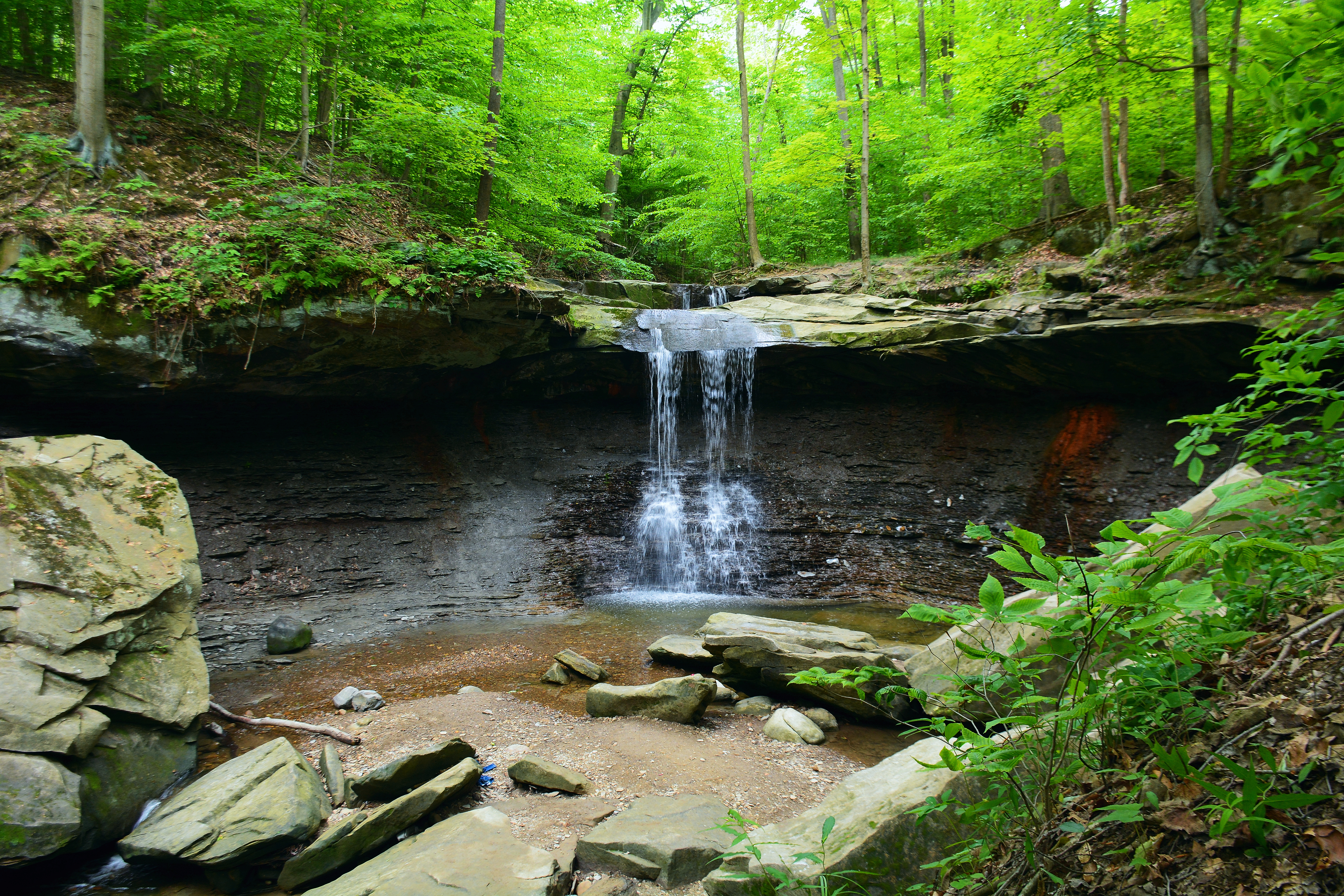
Article Summary: Historic Sites In Ohio
Historic Sites In Ohio. More Than Just Parks has 15 incredible must-see sites for you to visit.
I’ve been to so many of these amazing places since retiring from teaching in 2018. Did I mention that I taught history? I spent a lifetime teaching about the history behind these momentous sites. Then I got to see them firsthand. And now I’m sharing the stories of these incredible places with you. It doesn’t get any better than that!
I’m going to give you my list of the 15 Historic Sites In Ohio that you’ll want to see.
To be clear, this list includes national park sites (as in sites managed by the National Park Service) as opposed to national parks. It also includes sites not managed by the National Park Service. After all, we’re more than just parks!
If you are planning a trip to Ohio then you might want to pick up a copy of The Great Book of Ohio: The Crazy History of Ohio with Amazing Random Facts & Trivia by Bill O’Neill.
Without further ado, let’s dive in.
Table Of Contents: Historic Sites In Ohio
Top 15 Historic Sites In Ohio
15. The Ohio Statehouse

We’ve put together an amazing list of 15 Best Historic Sites In Ohio and we kickoff that list at #15 with the Ohio Statehouse.
The Ohio Statehouse is a prominent historic building located in Columbus, Ohio, and serves as the seat of government for the State of Ohio. The building has a rich history that dates back to the early 19th century.
The state of Ohio was admitted to the Union in 1803, and soon after, the state’s capital was moved from Chillicothe to Columbus. In 1838, the Ohio General Assembly authorized the construction of a new statehouse building in Columbus to replace the previous structure, which was considered inadequate.
Construction of the new Ohio Statehouse began in 1839 and was completed in 1861, although the building was not fully furnished and occupied until 1869. The Statehouse was designed by prominent architect Nathan B. Kelly, who created a Greek Revival-style building with a central rotunda, flanked by wings on either side.
It Was The Site Of Many Significant Events
The Ohio Statehouse has been the site of many significant events throughout its history. During the Civil War, the building was used as a military hospital for wounded soldiers. In 1865, the body of President Abraham Lincoln was brought to the Ohio Statehouse for public viewing during its funeral procession across the country.
Over the years, the Ohio Statehouse has undergone several renovations and expansions to accommodate the needs of the growing state government. In the early 20th century, a new Supreme Court chamber was added, and the building’s interior was remodeled to reflect a more Beaux-Arts style.
Today, the Ohio Statehouse remains an important symbol of Ohio’s rich history and serves as a hub for state government. The building is open to the public and offers guided tours, exhibits, and events throughout the year.
14. Armstrong Air & Space Museum
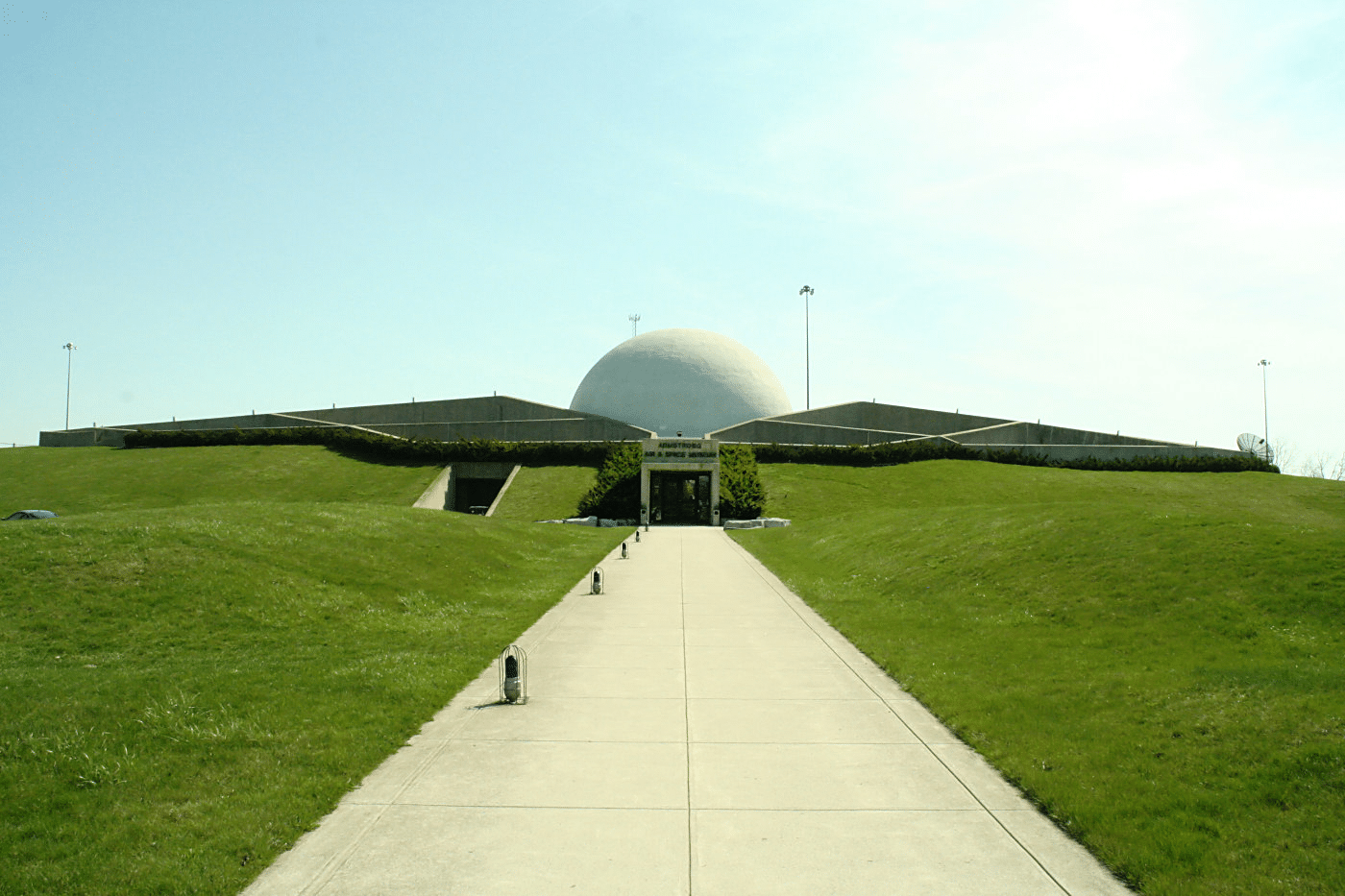
We move from the seat of Ohio’s government to the incredible story of the first man to walk on the moon. At #14 on our list of the Best Historic Sites In Ohio is the Neil Armstrong Air & Space Museum which is located in Wapakoneta, Ohio.
This incredible place is dedicated to the life and accomplishments of Astronaut Neil Armstrong who was the first human to walk on the Moon. The museum also celebrates Ohio’s contributions to space exploration and aviation.
It was founded in 1972, shortly after Neil Armstrong’s historic Apollo 11 mission, by a group of local residents who wanted to honor Armstrong’s achievements and inspire future generations of space explorers. The museum was built in Wapakoneta, Armstrong’s hometown, and features exhibits and artifacts related to his life and career.
The Armstrong Air & Space Museum was expanded in 1985 to include additional exhibits on aviation and space exploration. The museum features a variety of interactive displays, including simulators, models, and educational exhibits designed to engage visitors of all ages.
The museum’s most notable exhibit is a replica of the Gemini VIII spacecraft, the mission in which Armstrong served as the command pilot. The museum also features a Lunar Module simulator that allows visitors to experience what it was like to land on the moon.
In addition to its exhibits, the Armstrong Air & Space Museum hosts a variety of educational programs and events throughout the year, including lectures, workshops, and summer camps.
Neil Armstrong
Neil Armstrong (1930-2012) was the first person to walk on the moon. He was born in Ohio and had a passion for flying from a young age. After serving in the Korean War as a naval aviator, he became a test pilot and was selected as a NASA astronaut in 1962.
Armstrong first went to space in 1966 as the command pilot of the Gemini 8 mission, which completed the first docking of two spacecraft in orbit. However, he is most famous for his role as commander of the Apollo 11 mission in 1969, which aimed to land humans on the moon.
On July 20, 1969, Armstrong, along with fellow astronaut Edwin “Buzz” Aldrin, became the first humans to walk on the moon. Armstrong famously said the words, “That’s one small step for man, one giant leap for mankind,” as he stepped onto the lunar surface.
After his career as an astronaut, Armstrong served as a professor of engineering at the University of Cincinnati and also as a member of the investigation into the 1986 Challenger space shuttle disaster. He was a highly respected figure in the space community and is remembered as a hero of space exploration.
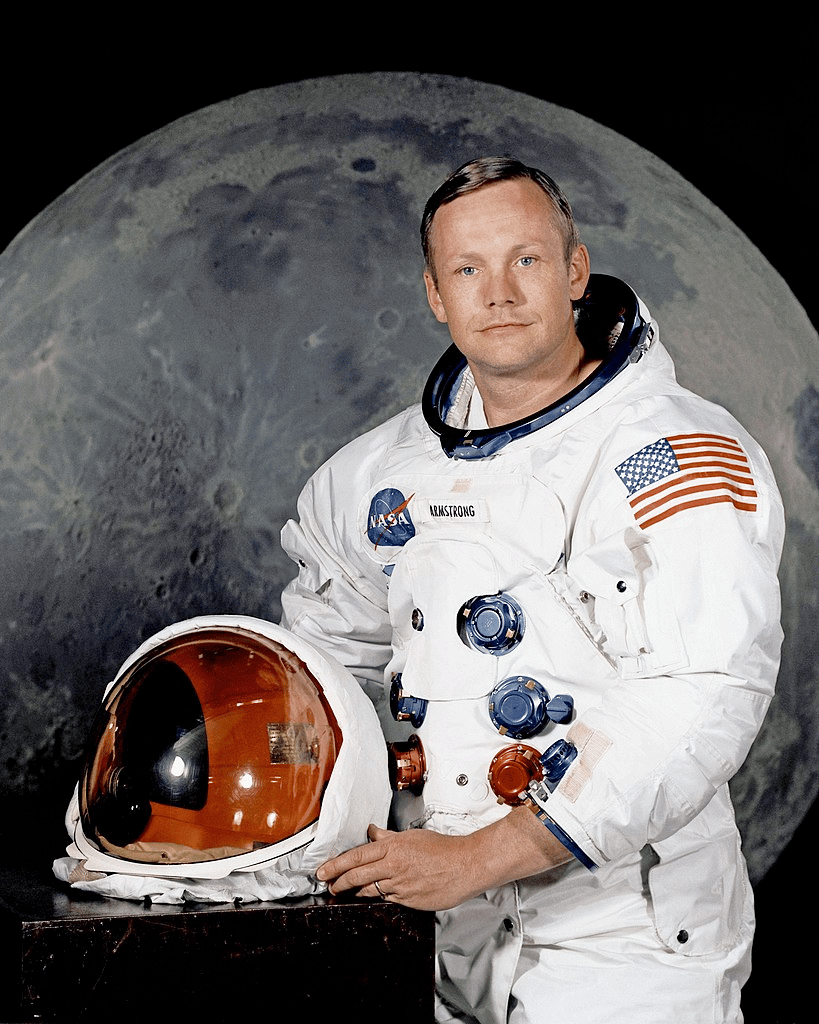
13. Thomas Edison Birthplace Museum
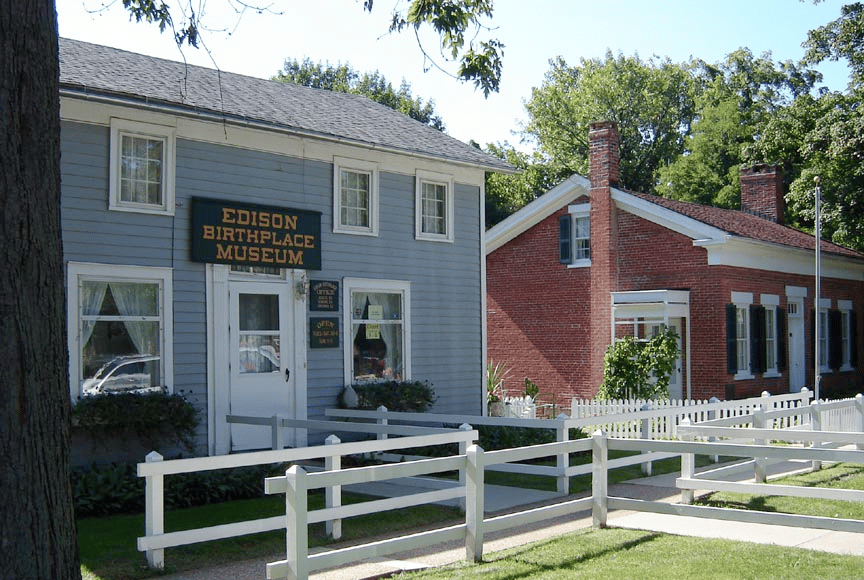
There’s so many incredible sites to see! We move from the story of the first man to walk on the Moon to the story of the man who illuminated our world. At #13 is the Thomas Edison Birthplace Museum in Milan, Ohio.
The Thomas Edison Birthplace Museum is a museum located in Milan, Ohio. The museum is housed in the home where Edison was born on February 11, 1847.
The Edison family lived in the home until 1854 when they moved to Port Huron, Michigan. The home fell into disrepair until 1906 when it was purchased by a group of local citizens who formed the Edison Birthplace Association to preserve the home as a museum.
The home was extensively restored and opened to the public in 1947 to celebrate the 100th anniversary of Edison’s birth. The museum features exhibits on Edison’s life and inventions, including telegraphs, phonographs, and light bulbs. It also includes a research library with a collection of books and documents related to Edison and his work.
Over the years, the Thomas Edison Birthplace Museum has undergone several renovations and expansions to accommodate the growing number of visitors. In 1995, the museum added a visitor center and gift shop to enhance the visitor experience.
Today, the Thomas Edison Birthplace Museum is an important attraction for visitors interested in learning about the life and work of Thomas Edison, one of the most influential inventors in history. The museum is open to the public and offers guided tours, educational programs, and events throughout the year.
Thomas Edison
Thomas Edison (1847-1931) was an American inventor, scientist, and businessman. He is best known for his invention of the electric light bulb, which is considered one of the most significant inventions of the modern era.
Edison was born in Ohio and began working as a telegraph operator at the age of 15. He later moved to New York City and started his own research and development laboratory, where he focused on inventing new devices and technologies.
Edison’s most famous invention is the incandescent light bulb, which he patented in 1879. This invention revolutionized the way people lived and worked, and led to the development of modern electric power systems. Edison also invented the phonograph, the motion picture camera, and the alkaline storage battery, among many other things.
In addition to his work as an inventor, Edison was also a successful businessman. He founded the Edison Electric Light Company and later merged it with the Thomson-Houston Electric Company to form General Electric, which is still one of the largest corporations in the world today.
Edison was one of the most prolific inventors in history, with over 1,000 patents to his name. He is widely regarded as a visionary and a pioneer in the field of electrical engineering, and his inventions have had a profound impact on modern society.
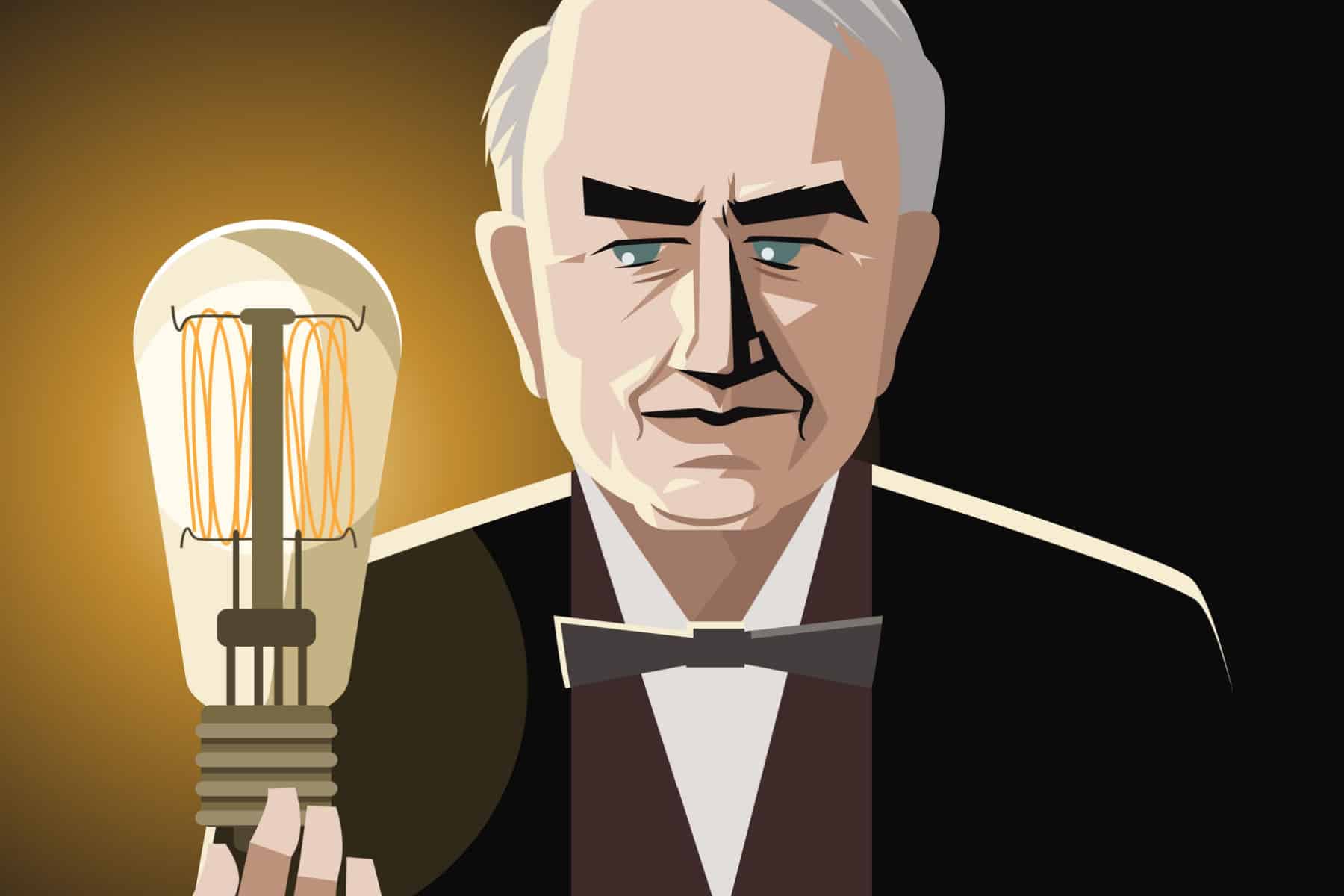
12. National Museum Of The United States Air Force
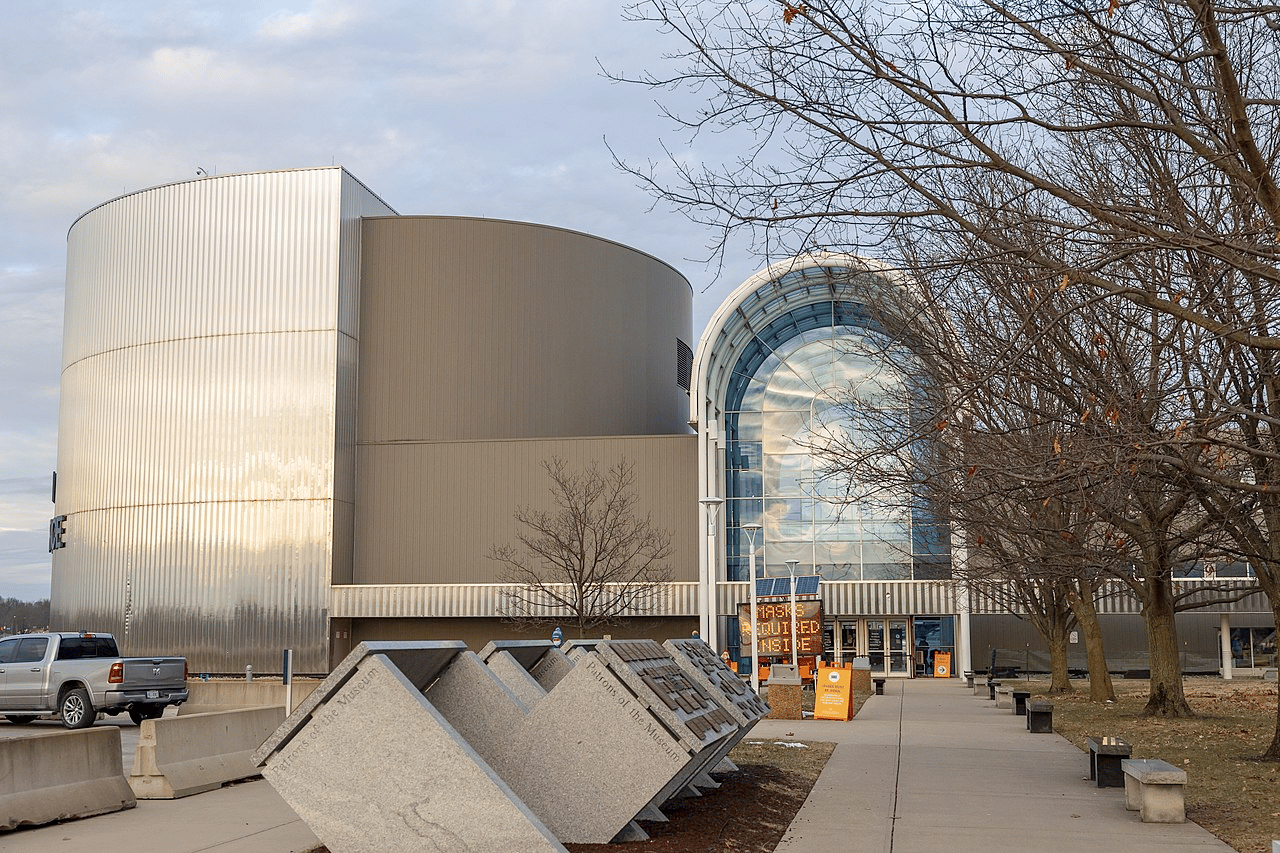
At #12 on our list of the Best Historic Sites in Ohio is a place which showcased the history and artifacts of one of the most important branches of the military. It’s the National Museum of the United States Air Force. The museum is the oldest and largest military aviation museum in the world.
The museum was established in 1923 as the Army Aeronautical Museum, located at McCook Field in Dayton, Ohio. The museum’s collection grew over the years, and in 1949, the museum was moved to Wright-Patterson Air Force Base, where it is still located today.
The museum was renamed the National Museum of the United States Air Force in 1961 and underwent a major expansion in 1971. The museum’s collection now includes more than 360 aircraft and missiles, as well as thousands of other historical artifacts, documents, and photographs related to the history of the Air Force.
The Museum Is Divided Into Several Galleries
The National Museum of the United States Air Force is divided into several galleries that cover different aspects of Air Force history, including: the early years of aviation, World War II, the Cold War, and space exploration. The museum also includes a Presidential Gallery, which displays aircraft that were used by U.S. presidents.
The museum offers a variety of exhibits and programs that are designed to educate and inspire visitors of all ages. Visitors can take guided tours, attend educational programs, and participate in hands-on activities. The museum also hosts a variety of events throughout the year, including air shows, concerts, and special exhibits.
Today, the National Museum of the United States Air Force is an important attraction for aviation enthusiasts, military historians, and anyone interested in the history of the United States Air Force. The museum’s collection and exhibits continue to inspire visitors with the Air Force’s legacy of innovation, courage, and dedication.
11. Lewis & Clark National Historic Trail
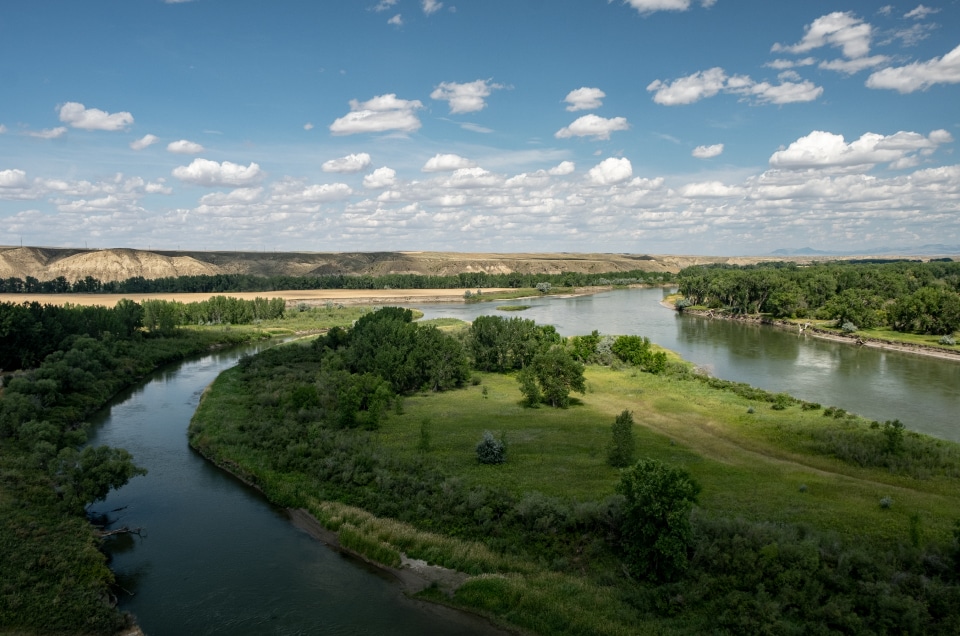
We go from a place which celebrates the men and women who fly the skies to an historic trail which follows the route first taken by Lewis & Clark. At #12 on our list of the Best Historic Sites In Ohio is the Lewis & Clark National Historic Trail.
The expedition was led by Meriwether Lewis and William Clark, and its goal was to explore the western portion of the Louisiana Territory, which had recently been acquired by the United States from France, and to find a water route to the Pacific Ocean.
During their journey, Lewis and Clark encountered various indigenous tribes, as well as stunning landscapes, and documented their findings in journals, maps, and sketches.
The trail covers approximately 4,900 miles, passing through 11 states, and offers a glimpse into the history of the American West, including the story of the first people who lived there and the natural beauty of the region.
It’s Part Of The National Trails System Act
The Lewis & Clark National Historic Trail was officially established by Congress in 1978 as a part of the National Trails System Act.
Today, the trail is managed by the National Park Service and is designated as a National Historic Trail, which means that it is protected as a cultural and historical resource for future generations to enjoy.
It offers opportunities for outdoor recreation, including hiking, boating, and camping, as well as educational programs and events that allow visitors to learn about the rich history of the region.
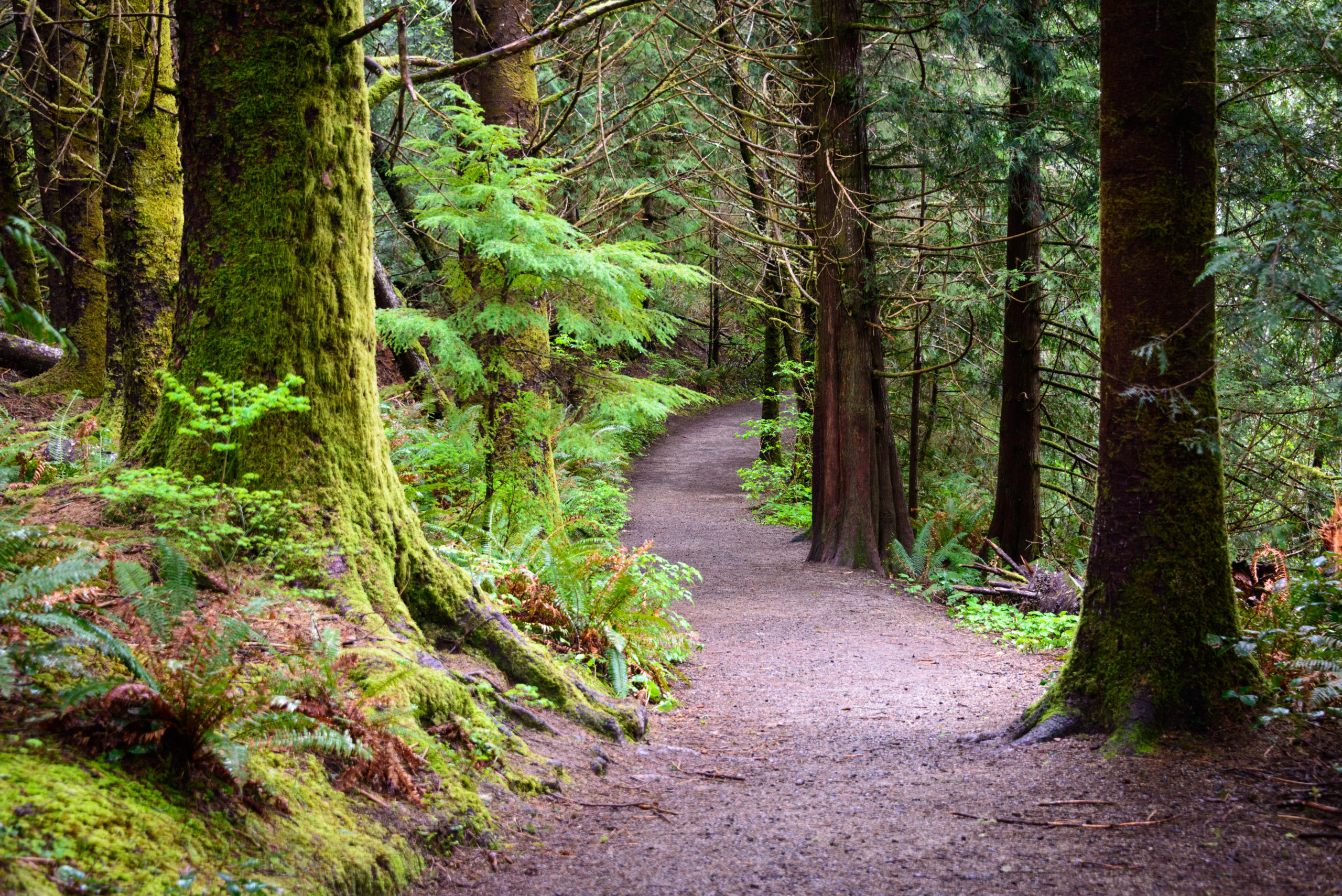
What Can I See In Ohio That’s Connected To Lewis & Clark
Places of interest to visit in Ohio include:
- Campus Martius Museum-Founded in 1788 by Rufus Putnam, Marietta, Ohio, was the first settlement established in the Northwest Territory. The stockade was known as Campus Martius, so named because it put settlers and soldiers alike in mind of the Fields of Mars, a training ground once used by ancient Roman legions.
- Eulett Center-The Eulett Center takes its name from Charles A. Eulett, a teacher and naturalist from Adams County who advocated for the protection of local prairies and grasslands in the 1960s and 70s. The nature preserve protects 20,000 acres of pristine forestlands, prairies, ravines, and slopes.
- Historic Fort Steuben-It’s a reconstructed military fort located in Steubenville, Ohio, along the Ohio River. The Reconstruction of Fort Steuben began shortly after 1986, 200 years after the fort’s initial creation, and was led by the Old Fort Steuben Project. (Source: NPS)

CHECK OUT: 25 Bucket List Famous Landmarks In America (MUST-SEE)
Top 10 Historic Sites In Ohio
10. Hopewell Culture National Historic Park
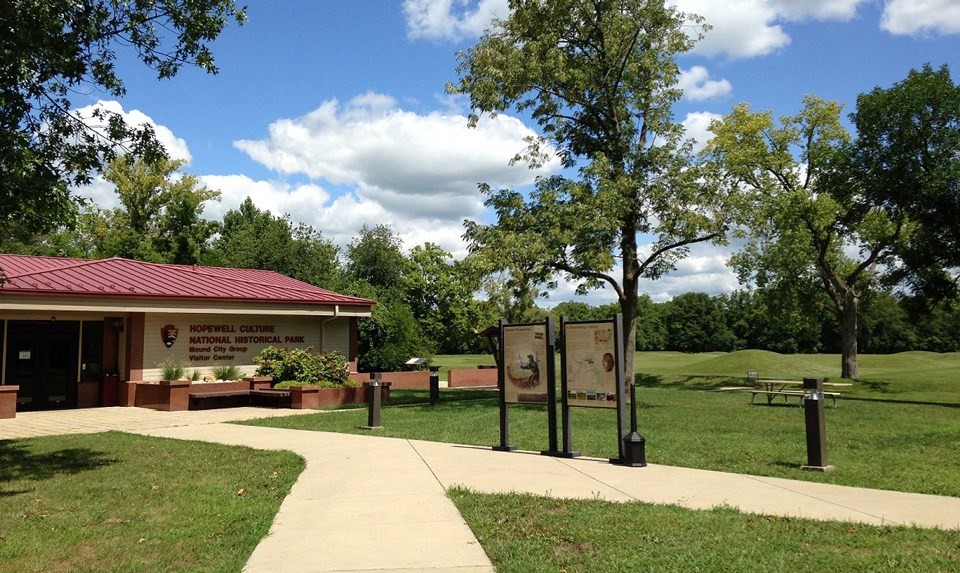
We’re on to the Top 10 Historic Sites In Ohio. At #10 we have an amazing place which preserves and interprets the archaeological remains of the Hopewell culture, a pre-Columbian indigenous culture that flourished in the area from about 200 BCE to 500 CE. It’s the Hopewell Culture National Historic Park located in Ross County, Ohio.
The park is centered around the Mound City Group, a group of 23 earthen mounds and earthworks that were built by the Hopewell people. Visitors can explore the mounds and earthworks on foot, and there is also a visitor center with exhibits that provide information about the Hopewell culture and its history.
The Hopewell people lived in the Ohio River Valley between 100 BCE and 500 CE and are known for their impressive earthworks, sophisticated trade networks, and complex social systems.
The park was established in 1923 to protect the Mound City Group, a collection of 23 mounds and earthworks that were built by the Hopewell culture. The park was expanded in the 1930s to include additional earthworks and artifacts, and in 1992, it was designated a National Historic Park.
Some Of The Largest & Most Impressive Earthworks Built By The Hopewell People
The Hopewell Culture National Historic Park is home to some of the largest and most impressive earthworks built by the Hopewell people, including the Great Circle, which is a large circular earthwork that measures more than 1,000 feet in diameter.
The park also includes several burial mounds, geometric earthworks, and a visitor center with exhibits and educational programs.
The park’s exhibits and educational programs explore the Hopewell culture’s social and economic systems, their artistic and religious practices, and their relationship with the natural world. Visitors can take guided tours of the earthworks and participate in educational programs that offer hands-on learning opportunities.
Today, the Hopewell Culture National Historic Park is an important attraction for visitors interested in learning about the ancient cultures that once inhabited the Ohio River Valley. The park’s earthworks and artifacts continue to inspire visitors with their beauty, complexity, and historical significance.
CHECK OUT: All 63 US NATIONAL PARKS RANKED BY EXPERTS
9. James A. Garfield National Historic Site
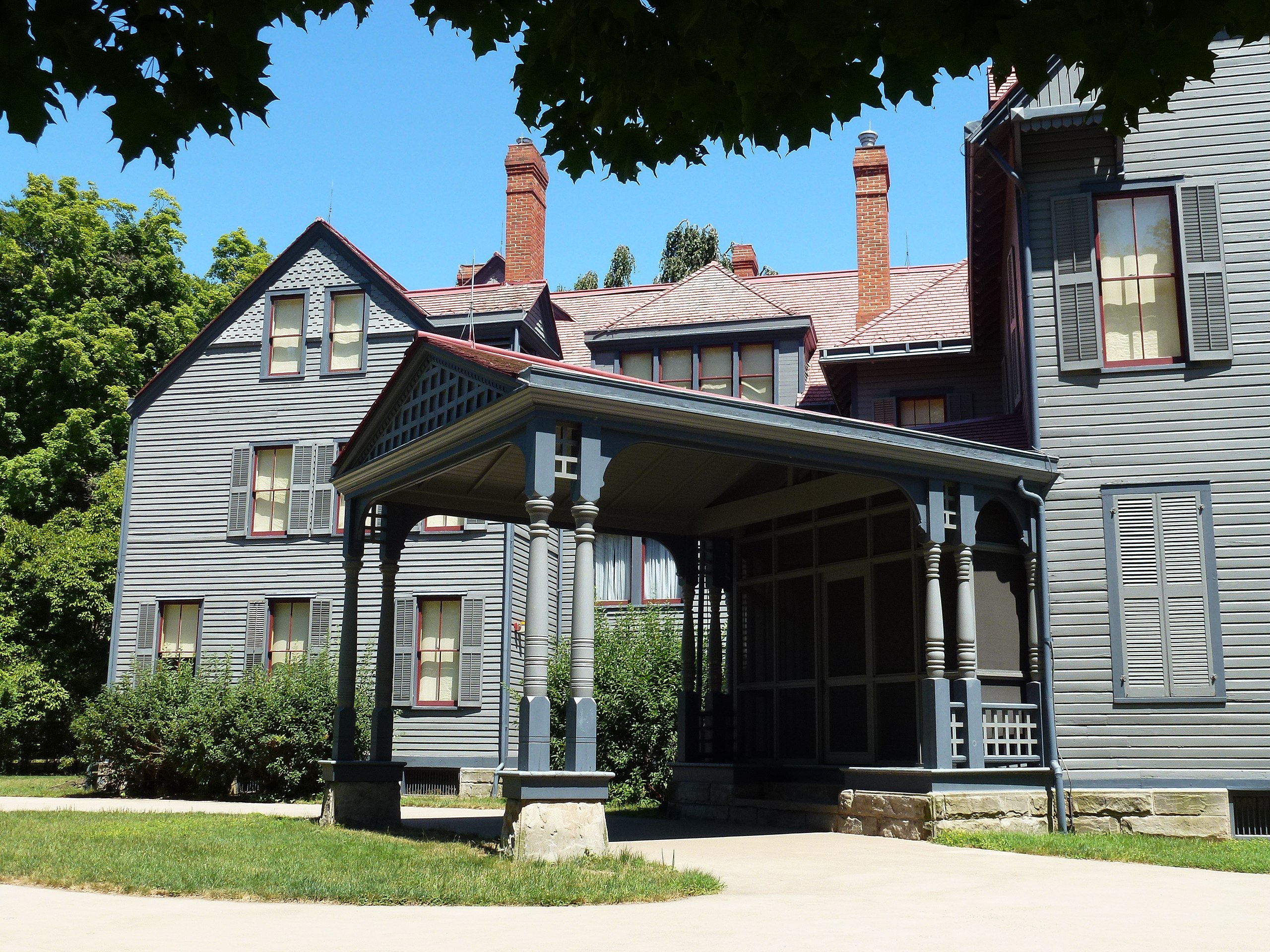
Did you know that more of our country’s presidents come from Ohio than from any other state? Eight of 44 American presidents were elected from the Buckeye State, earning Ohio the nickname “the Mother of Presidents.”
It’s therefore fitting that, at #9 on our list of the Best Historic Sites In Ohio, is the James A. Garfield National Historic Site.
James A. Garfield served as Brigadier General in the Civil War. President Abraham Lincoln, however, felt that Garfield could be of greater use to the Union cause in Congress.
So, being a good soldier, Garfield resigned his commission in 1862 to serve eighteen years in Congress. He became the leading Republican in the House of Representations.
In 1880, Garfield was nominated for the presidency. He defeated his Democratic opponent, another former Civil War General named Winfield Scott Hancock, by a mere 10,000 votes.
Historians consider Garfield to have been a “brilliant maybe.” He was committed to political reform and hemispheric cooperation. Sadly, on July 2nd, 1881, he was struck by an assassin’s bullet.
Garfield spent two and a half months in a slow, agonizing decline before dying on September 19, 1881.
To learn more about this fascinating individual I recommend reading Destiny of the Republic: A Tale of Madness, Medicine and the Murder of a President by Candice Millard.
Things To Do At The James A. Garfield National Historic Site
The site offers a variety of activities and attractions that are designed to educate and inspire visitors of all ages. Here are some of the things to do at the James A. Garfield National Historic Site:
- Take a guided tour of the Garfield home – Visitors can take a guided tour of the Garfield home, which has been restored to its 1880s appearance. The tour provides an intimate look at the home where President Garfield lived and worked before his assassination in 1881.
- Explore the grounds and gardens – The Garfield site features several acres of grounds and gardens that visitors can explore. The grounds include a carriage house, a barn, and a windmill, as well as several gardens that are maintained by the site’s staff.
- Visit the visitor center – The visitor center features exhibits that explore the life and legacy of President Garfield. Visitors can view artifacts from Garfield’s life and career, as well as interactive exhibits that offer a deeper understanding of his presidency and his impact on American history.
- Attend a special event – The Garfield site hosts a variety of special events throughout the year, including living history programs, lectures, and musical performances. Visitors can check the site’s calendar of events to find out what’s happening during their visit.
- Explore the surrounding area – The Garfield site is located in the heart of Lake County, Ohio, which offers a variety of attractions and activities for visitors. From wineries and breweries to parks and beaches, Lake County has something for everyone.

CHECK OUT: List Of 128 BEST US NATIONAL MONUMENTS-RANKED
8. Pro Football Hall Of Fame

We haven’t forgotten about those of you who love sports. Did you know that the 2023 edition of the Super Bowl, which saw the Kansas City Chiefs emerge victorious against the Philadelphia Eagles was watched by 113 million viewers in the United States.
In Ohio you can visit the place which celebrates professional football. At #8 on our list of the Best Historic Sites In Ohio is the Pro Football Hall Of Fame.
The Pro Football Hall of Fame honors the greatest players, coaches, and contributors to the sport of American football. It is considered the premier institution for preserving and showcasing the history of the game, and attracts visitors from around the world.
Some of the things to see and do at the Pro Football Hall of Fame include:
- Hall of Fame Gallery: Visitors can view the bronze busts of all the inducted members of the Hall of Fame, as well as learn about their careers and achievements.
- Interactive Exhibits: The museum features interactive exhibits that allow visitors to experience what it’s like to play professional football, including simulations, virtual reality experiences, and more.
- Artifacts and Memorabilia: The Hall of Fame has a large collection of artifacts and memorabilia related to the sport, including game-worn jerseys, historic photographs, and more.
- Enshrinement Ceremony: The Hall of Fame hosts an annual Enshrinement Ceremony, where new inductees are honored and their busts are unveiled.
- Events and Programs: The museum offers various events and programs throughout the year, including educational programs, youth camps, and more.

7. Perry’s Victory & International Peace Memorial

We move from one of the more celebrated sites in the state of Ohio to a site which celebrates one of the heroes of the War of 1812. At #7 on our list of the Best Historic Sites In Ohio is Perry’s Victory & International Peace Memorial.
The War Of 1812
The War of 1812 was a conflict between the United States and Great Britain that took place from 1812 to 1815. The war was primarily fought over issues related to trade, maritime rights, and territorial expansion. It was also influenced by tensions between the United States and Great Britain that had been simmering since the American Revolution.
One of the primary causes of the war was British interference with American trade. The British had been seizing American ships and impressing American sailors into service on British warships. The United States also had territorial ambitions, and many Americans believed that Canada would be easy to conquer.
Initially, the war did not go well for the United States, with American forces suffering several defeats on land and at sea. However, the tide of the war began to turn in 1813, when American forces won a series of naval battles on the Great Lakes and successfully defended the city of Baltimore against a British attack.
The war continued for several more years, with both sides suffering significant casualties and incurring significant economic costs. However, by 1814, both sides were eager to end the conflict. In December 1814, the two sides signed the Treaty of Ghent, which ended the war and restored pre-war boundaries.
Although the war ended in a stalemate and did not result in any significant territorial gains for the United States, it did have several important consequences. The war cemented the United States’ independence from Great Britain and established the nation as a major world power.
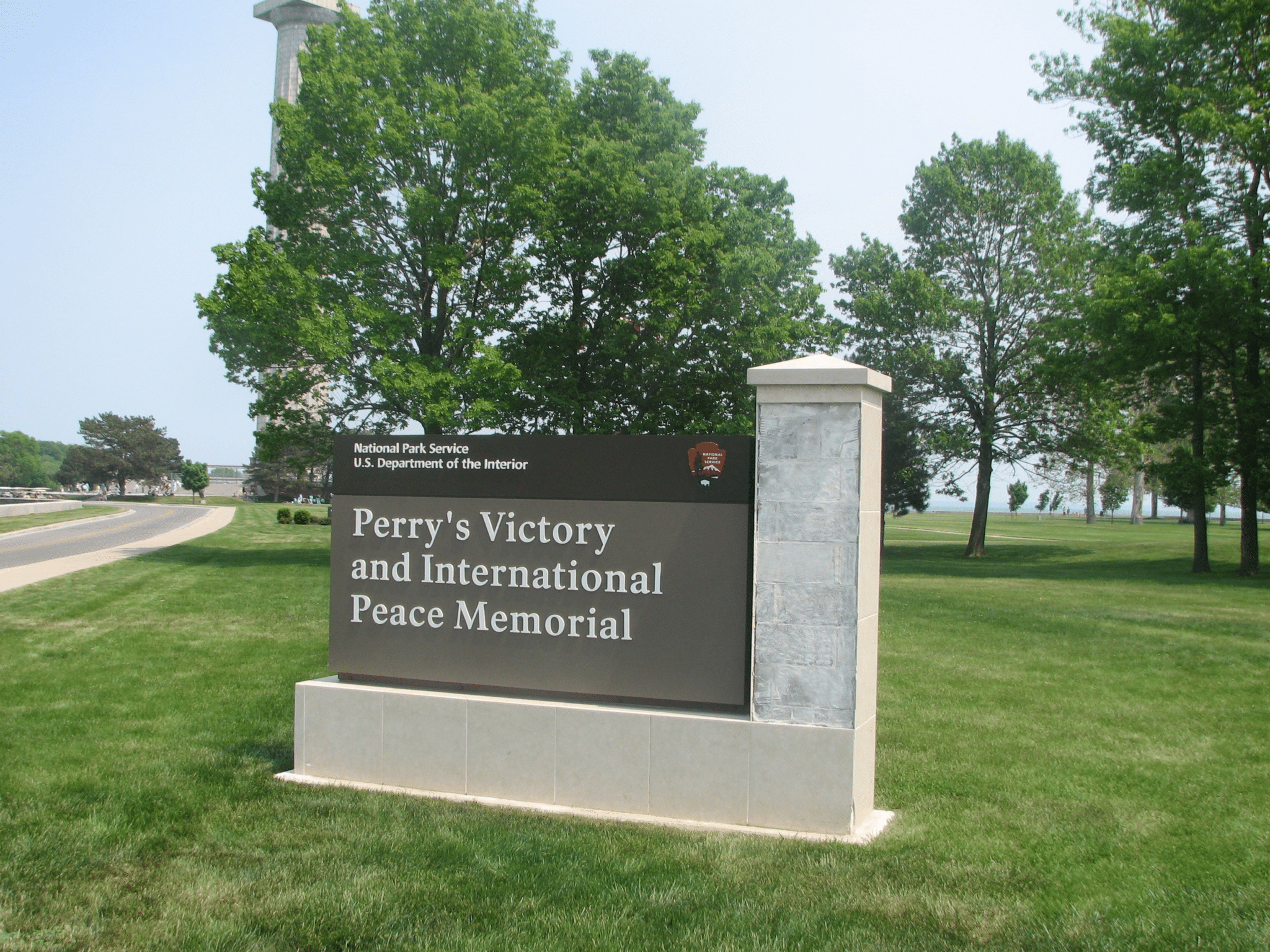
See The Monument Which Honors Oliver Hazard Perry
Perry’s Victory & International Peace Memorial commemorates the Battle of Lake Erie, which took place during the War of 1812.
The monument was built to honor the victory of American naval forces, led by Commodore Oliver Hazard Perry, over the British in the battle, and to symbolize the lasting peace between the United States, Canada, and Great Britain.
The memorial consists of a 352-foot-tall Doric column, which is the third tallest stone column in the world, and offers panoramic views of Lake Erie and the surrounding islands. The monument also features a museum that showcases the history of the War of 1812 and the Battle of Lake Erie, as well as the peace that followed.
Visitors to Perry’s Victory & International Peace Memorial can take a guided tour of the monument, learn about the battle and its significance through interactive exhibits and displays, and climb to the top of the column for breathtaking views of the surrounding area.
The memorial is also a popular spot for picnics, bird-watching, and hiking, and is a symbol of American patriotism and international peace.
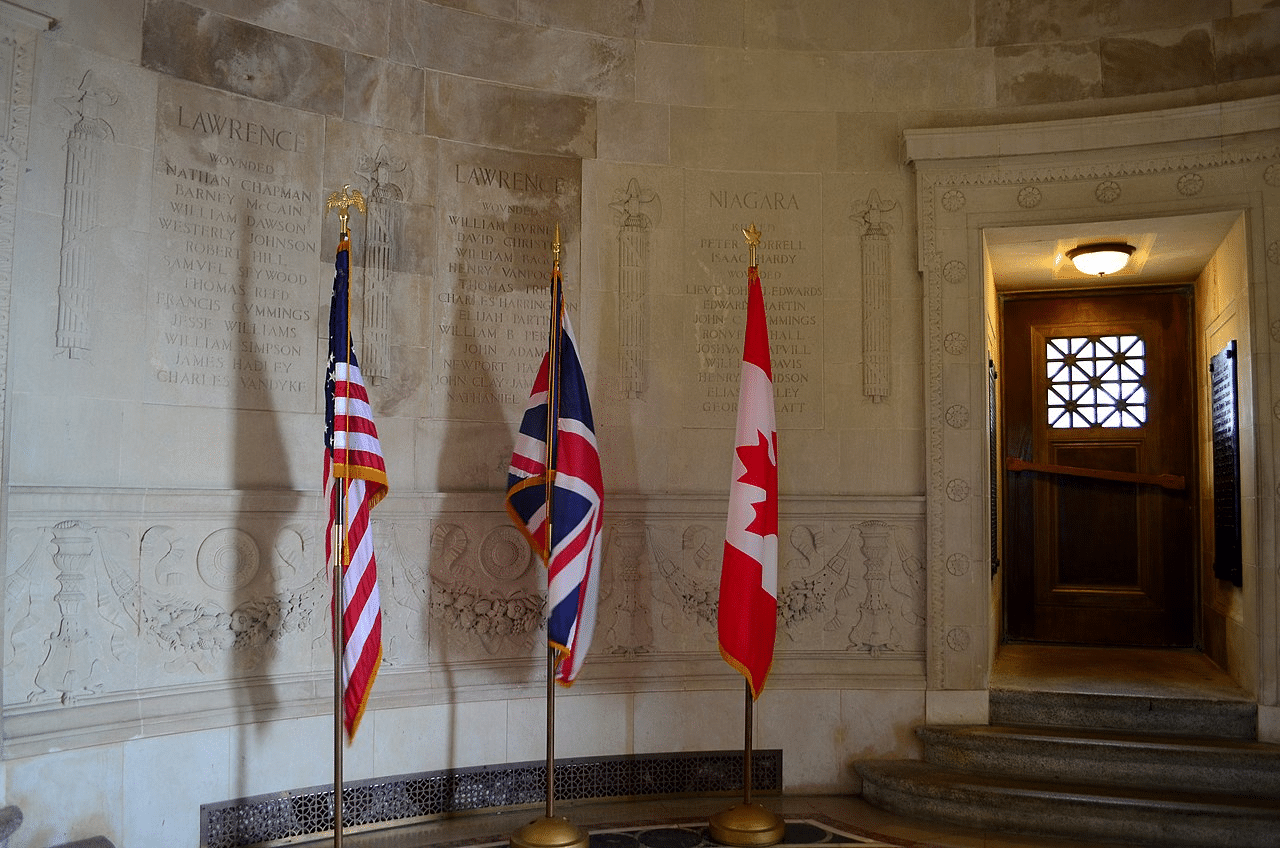
RELATED: 20 MUST-SEE Historic Sites In New York
6. Charles Young Buffalo Soldiers National Monument

In compiling our list of the Best Historic Sites In Ohio we were particularly impressed by some of history’s unsung heroes. One example is Oliver Hazard Perry. Another is Charles Young.
At #6 on our list of the Best Historic Sites In Ohio is the Charles Young Buffalo Soldiers National Monument.
A Truly Extraordinary Life
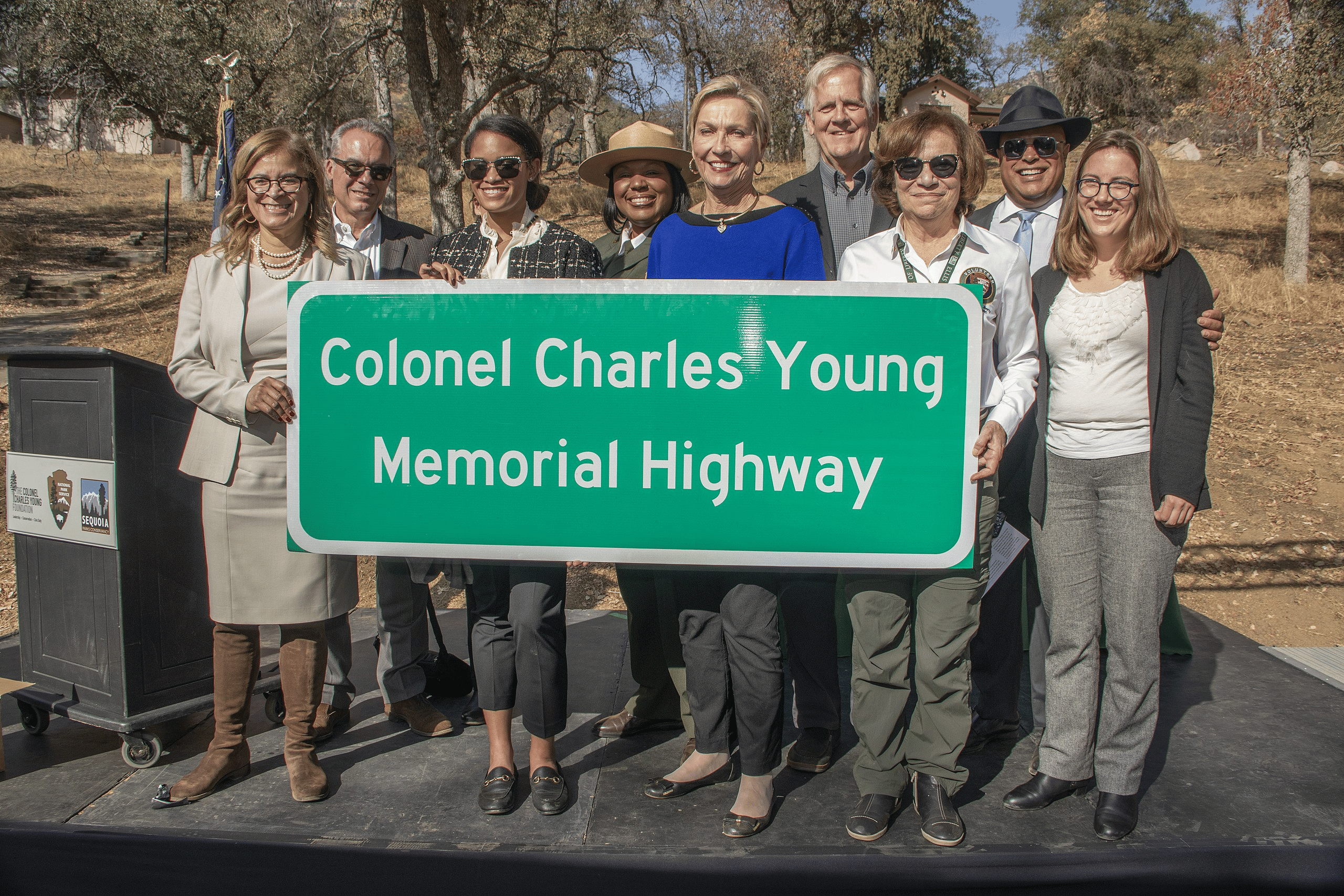
Born as a slave during the American Civil War, Charles Young lived a truly extraordinary life. He was the first African American to graduate from a white high school in Ohio. In 1884, Young defied the odds winning an appointment to West Point though a competitive military examination.
After confronting the racism which was unfortunately typical of his era, he emerged as only the third African American to graduate from America’s most prestigious military academy.
As a former history teacher and a lifelong history buff, I love to include book recommendations for those of you who are interested in taking a deeper dive.
In the case of Charles Young, I heartily recommend Black Officer in a Buffalo Soldier Regiment: The Military Career of Charles Young by Brian G. Shellum.
Captain Of An All Black Regiment
Young served as a cavalry officer. He then became the captain of an all-black regiment at San Francisco’s Presidio. Young’s career path would take an interesting turn when managing the national parks became the responsibility of the U.S. Army beginning in 1891.
This was before the creation of a unified system of national parks or the establishment of an elite cadre of park rangers.
By 1903, the U.S. Military was providing protection at America’s parks. Young was assigned to take his troops to Sequoia and General Grant (what is now Sequoia National Park and a small portion of Kings Canyon National Park).
It was during the summer of 1903 that he made history by becoming the acting superintendent of the these two parks. He was the first African-American to hold such a position.
RELATED: Meet The Real Life Batman & Robin Of The National Parks
Things To Do At The Charles Young Buffalo Soldiers National Monument
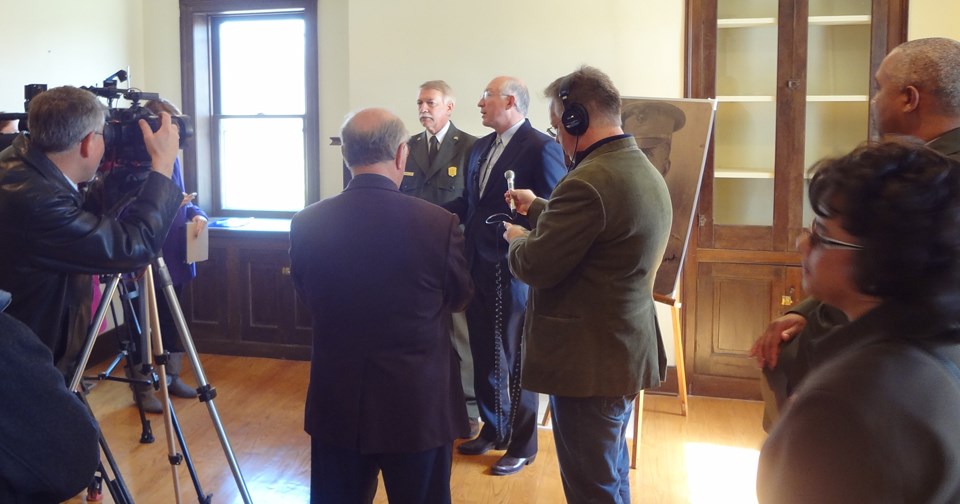
Young was sidelined from active duty during World War One due to health issues, but returned to command after the war. He would earn the rank of colonel. Young died unexpectedly, however, in 1922.
As the National Park Service notes, Charles Young overcame stifling inequality to become a leading figure in the years after the Civil War when the United States emerged as a world power.
His work ethic, academic leadership, and devotion to duty provided a strong base for his achievements in the face of racism and oppression.
His long and distinguished career as a commissioned officer in the United States Army made him a popular figure of his time and a role model for generations of new leaders.
Visitors to the site can take a guided tour of the Charles Young Home. Here you can learn more about the incredible story of this remarkable man.
Top 5 Historic Sites In Ohio
5. First Ladies National Historic Site

We’re on to the Top 5 Historic Sites In Ohio. At #5 is a site which celebrates some of the most influential women in American history. It’s the First Ladies National Historic Site.
The site honors the contributions of America’s First Ladies and preserves the history of the role of the First Lady in American political and social life. It is the only site of its kind in the United States.
The site is located in the former home of William McKinley’s Ida Saxton McKinley, who served as First Lady during McKinley’s presidency from 1897 to 1901. The house has been restored to its late 19th-century appearance and features exhibits and displays that explore the lives and legacies of America’s First Ladies.
Visitors to the First Ladies National Historic Site can take a guided tour of the McKinley home and explore exhibits that highlight the accomplishments and contributions of the First Ladies.
Exhibits feature objects, photographs, and documents from the lives of the First Ladies, including their contributions to American society, their advocacy for important causes, and their personal stories.
America’s Most Influential First Lady
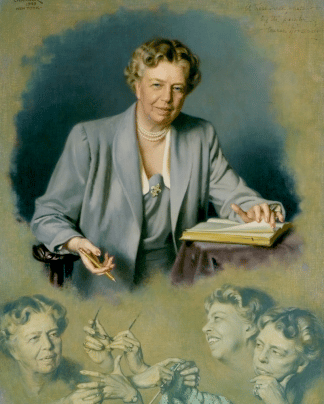
If you’re someone who follows sports then you’re likely familiar with rankings. As a long-time resident of Georgia, I assure you that I do follow sports especially college football.
In college football and almost everything else, most rankings tend to change over time. And yet the woman considered by many knowledgeable experts to be America’s Most Influential First Lady hasn’t changed over time.
After the scrutiny of three expert opinion surveys over twenty years, Eleanor Roosevelt is still ranked first among all other women who have served as America’s First Ladies, according to an expert opinion poll conducted by the Siena (College) Research Institute (SRI).
America’s Longest Serving First Lady
Eleanor Roosevelt served as First Lady for over 12 years. She played an active role in advising her husband and was the first first lady to hold her own press conferences.
Mrs. Roosevelt also championed causes, such as Women’s Rights, and supported programs, such as the one which gave African Americans the opportunity to become fighter pilots during World War Two.
Eleanor Roosevelt was the first first lady to remain an influential political force after her husband’s death. She served as Chair of the United Nations Commission on Human Rights.
If you’re interested in learning more about this remarkable First Lady then I recommend Eleanor Roosevelt, Fighter for Justice: Her Impact on the Civil Rights Movement, the White House, and the World by Ilene Cooper.
RELATED: 15 MUST-SEE Historic Sites In Georgia
4. William Howard Taft National Historic Site
We’re on to the “Final Four.” Since Ohio is home to more presidents than any other state we thought it fitting to include another presidential site on our list of the Best Historic Sites In Ohio. At #4 we have the William Howard Taft National Historic Site.
While he is not considered a great president, he’s most certainly considered a large one. Weighing in at upwards of 330 pounds, William Howard Taft was the largest man ever to hold the office.
Taft had studied law and served in several minor appointive offices until 1887, when he was named to fill the unfinished term of a judge of the superior court of Ohio.
From 1892 to 1900 he served as a judge of the United States Sixth Circuit Court of Appeals. So far, nothing he did brought him any special distinction, but that was about to change.
Governor OF The Philippines & Secretary Of War
In 1901, Taft became the first civilian governor of the Philippines under President William McKinley. His administration of the Philippines was considered a success.
In 1904, Taft returned to Washington to serve as Theodore Roosevelt’s secretary of war. Four years later, Roosevelt endorsed him for the presidency. He was elected in 1908.
During his tenure in office, William Howard Taft signed the first tariff revision since 1897; established a postal savings system; formed the Interstate Commerce Commission; and prosecuted over 75 antitrust violations, far more than pursued by the famed “trust- buster” Theodore Roosevelt.
10th Chief Justice Of The Supreme Court
Did you know that William Howard Taft was the only president to also serve on the Supreme Court? He was the 10th Chief Justice of the U.S. Supreme Court.
Visitors will take a trip back in time as the home is decorated in Victorian-era style, which it was during the years that William Howard Taft lived in the house.
To learn more about this fascinating figure check out The William Howard Taft Presidency by Lewis L. Gould.
Things To Do At The William Howard Taft National Historic Site
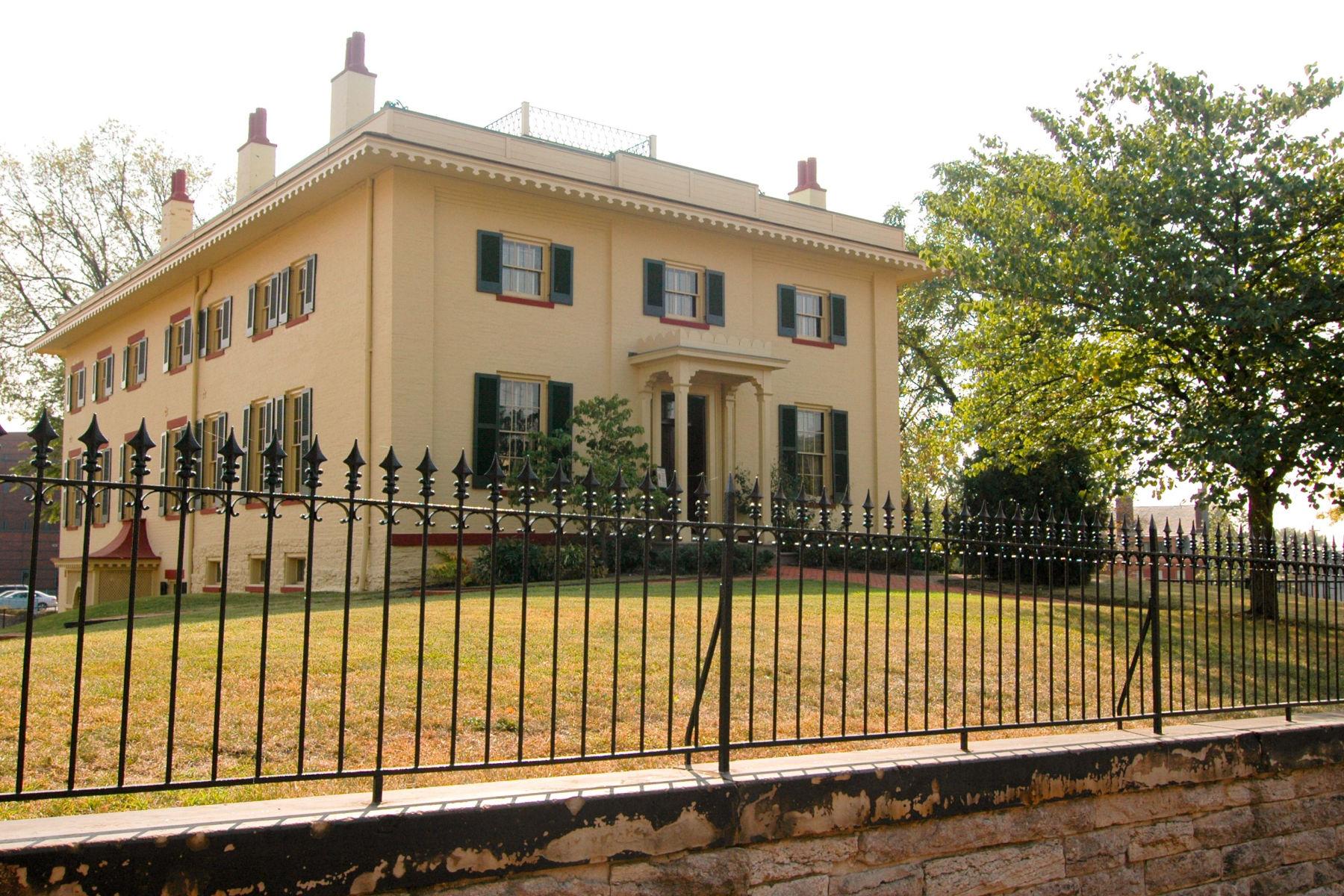
I recommend beginning at the Taft Education Center. It’s the park’s only visitor center. There you can see the film, William Howard Taft, Public Servant.
It’s approximately 15 minutes and covers the life and legacy of Taft and his career as a judge and a politician from the local level through the federal ranks.
There’s also a gift shop with souvenirs and an assortment of Taft and presidential-related books.
From there you can take a ranger-guided tour of the birthplace and home to the nation’s 27th President.
3. Cuyahoga Valley National Park

Just because we’re More Than Just Parks that doesn’t mean that we’ve forgotten about parks. At #3 on our list of the Best Historic Sites In Ohio is Ohio’s only national park – Cuyahoga Valley National Park.
You may have driven, fished, hiked, rode horseback, skied or swam in a national park, but did you ever travel through it by train? All Aboard the Cuyahoga Valley Scenic Railroad!
Visitors to this national park can experience its natural wonders onboard a train as it winds its way through the Cuyahoga Valley and along the Cuyahoga River.
The trip by train provides passengers the opportunity to possibly spot eagles, deer, beavers, and herons in their natural habitat. It’s a great way to travel!
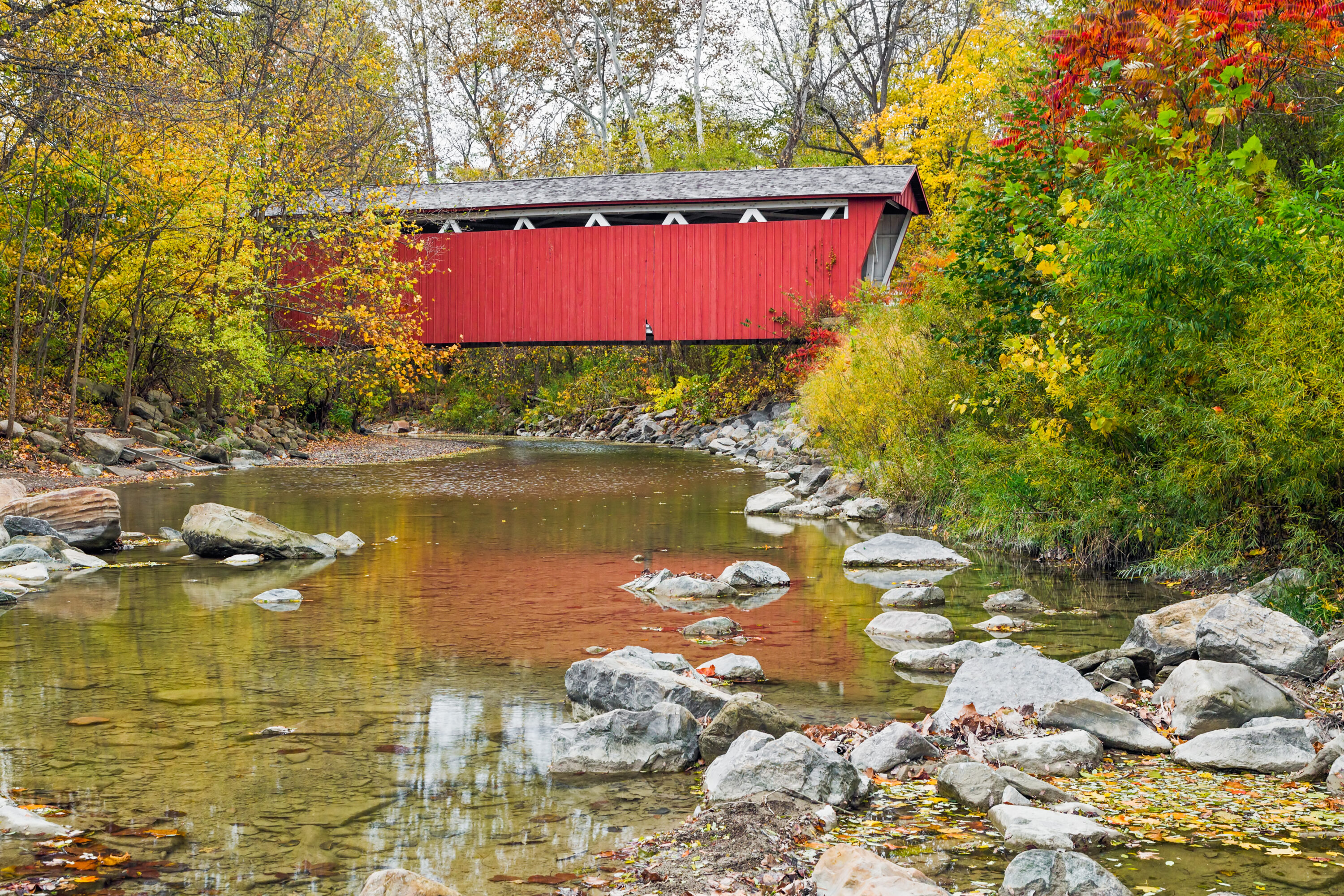
Hiking At Cuyahoga
Of course you don’t have to travel by train. There are over 125 miles of hiking trails available too. These trails range from nearly-level to more challenging, and pass through various habitats including woodlands, wetlands, and old fields.
If you’re looking to do some serious hiking then I would recommend picking up a copy of the Trail Guide Handbook: Cuyahoga Valley National Recreation Area. It’s an excellent resource which will enable you to make the most of your hiking experiences while at Cuyahoga.
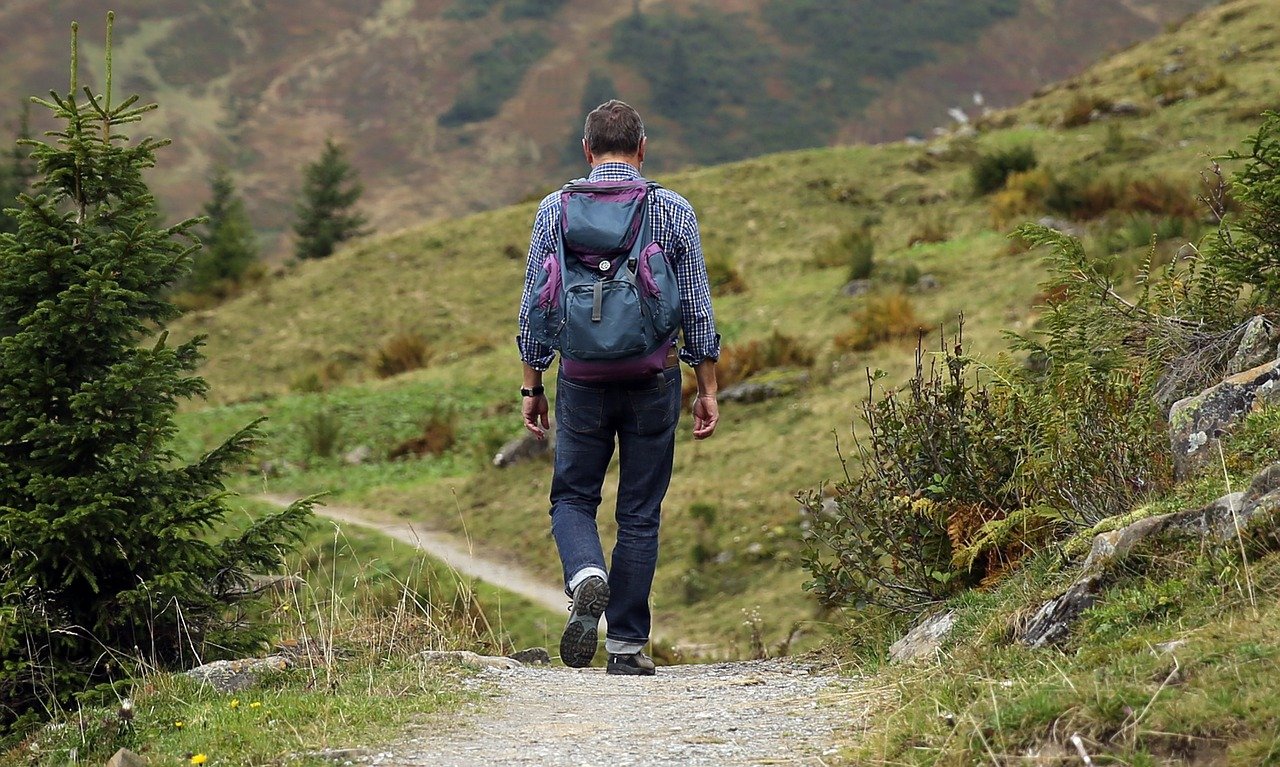
CHECK OUT: 10 FASCINATING Facts About Cuyahoga Valley National Park
Other Things To Do At Cuyahoga Valley National Park
Popular attractions and activities include:
- Beaver Marsh where you will enjoy exceptional scenery and wildlife. It’s one of the park’s most popular destinations.
- Brandywine Falls which is a magnificent 60-foot waterfall that’s accessed by boardwalk.
- The Ritchie Ledges are a geologic wonder. The trail around The Ledges is 2.2 miles and connects to a larger network of trails in the Virginia Kendall Area.
- Blue Hen Falls is a 15-foot waterfall. To get there you will hike 1.5 miles (one way) from Boston Mill Visitor Center.
- The Ohio & Erie Canal Towpath Trail is accessible by biking, walking or even wheelchair.
Cuyahoga Valley National Park also offers boating, fishing and horseback riding trails too.
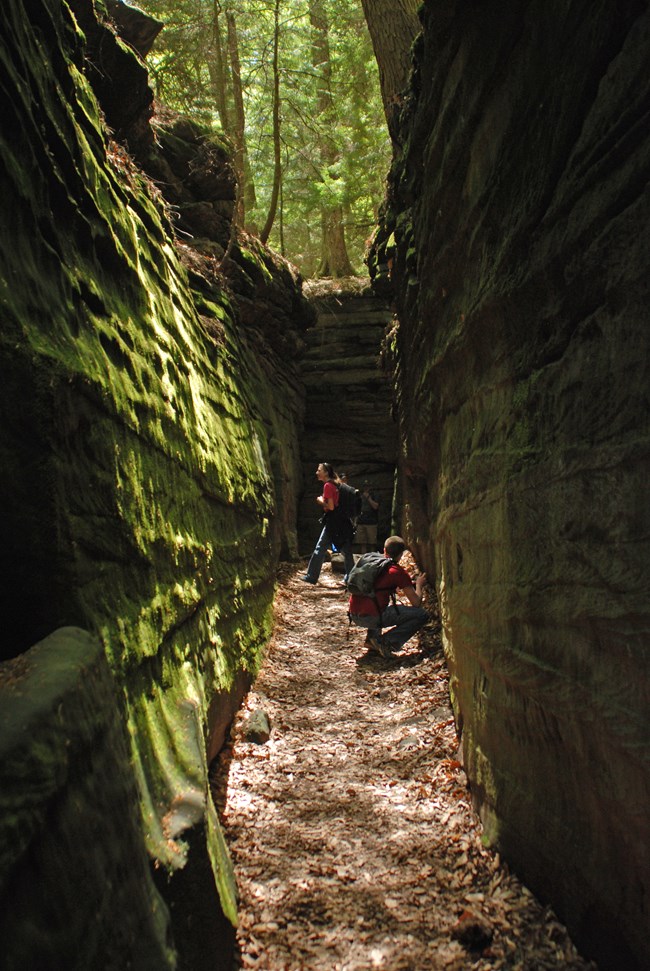
2. Rock & Roll Hall Of Fame

We’ve gone from pro football to presidents, first ladies and so much more. But are you ready to shake, rattle and roll? Our runner-up at #2 on our list of the Best Historic Sites In Ohio is the Rock & Roll Hall Of Fame & Museum.
The Rock & Roll Hall of Fame is a museum and cultural institution located in Cleveland, Ohio, that honors and celebrates the history of rock and roll music. The idea for the museum was first proposed in the early 1980s by Ahmet Ertegun, the founder of Atlantic Records, and a group of music industry executives.
The museum officially opened in 1995, after years of planning and fundraising. The building, designed by renowned architect I.M. Pei, is located on the shores of Lake Erie and features a striking geometric design that has become an iconic symbol of the city of Cleveland.
The Museum Features A Vast Collection Of Artifacts
The Rock & Roll Hall of Fame honors and celebrates the history and cultural significance of rock and roll music through a variety of exhibits, displays, and interactive experiences. The museum features a vast collection of artifacts, including musical instruments, stage costumes, and handwritten lyrics, that tell the stories of the most influential and iconic figures in rock and roll history.
The Rock & Roll Hall of Fame also honors the artists who have made significant contributions to the genre through induction into the Hall of Fame. Induction into the Hall of Fame is considered one of the highest honors in the music industry and is determined by a committee of music industry professionals and historians.
Since its opening, the Rock & Roll Hall of Fame has become one of the most popular tourist destinations in Cleveland, attracting millions of visitors from around the world each year. The museum has also played an important role in promoting and preserving the history of rock and roll music and continues to inspire and influence new generations of musicians and fans.
1. Dayton Aviation Heritage National Historical Park
We’ve featured the first man to walk on the Moon as well as the United States Air Force, but our #1 Historic Site In Ohio celebrates the two men which first made manned-flight possible. More Than Just Parks #1 Historic Site Is The Dayton Aviation Heritage National Historical Park.
Growing up you were probably taught that “two wrongs don’t make a right.” But did you know that “two Wrights could make one fabulous airplane?”
All joking aside, on a cold, windy morning on December 17, 1903, history was made. It was at the sandy dunes of Kitty Hawk, North Carolina, that two Ohio brothers changed the world.
These two intrepid brothers, named Orville and Wilbur Wright, built and successfully tested the first airplane, the Wright Flyer 1. They were early pioneers of flight who faced tremendous obstacles.
The Wrights were ridiculed as cranks and fools. As award-winning author and historian David McCullough notes:
I don’t think they were ever happier in their lives than they were living in the extreme hardships of Kitty Hawk. The attacks of mosquitos, the winds, the struggle they had against the elements. But they loved it.”
They Had The Wright Stuff
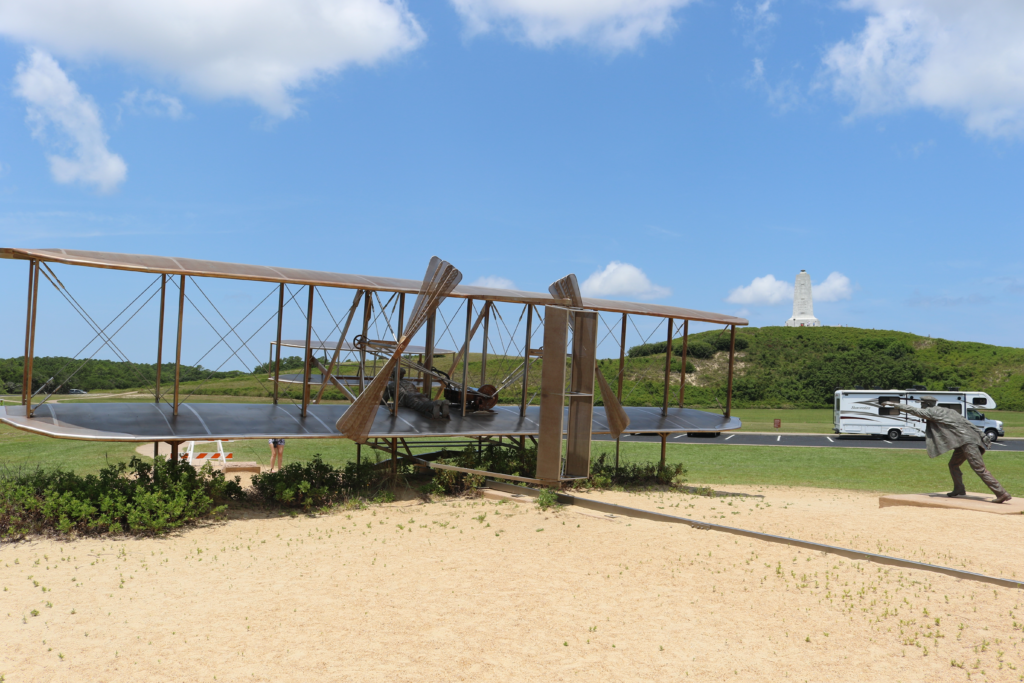
Before experimenting with airplanes, the Wright brothers ran a bicycle shop in Dayton, Ohio. In 1900, the brothers traveled from Ohio to Kitty Hawk, North Carolina, to begin a series of flight experiments which would rewrite the history of aviation.
While their historic flight lasted only 12 seconds it was nevertheless the first flight in history in which a machine carrying a man had raised itself by its own power into the air in full flight, had sailed forward without reduction of speed, and had finally landed at a point as high as that from which it started.
One book I would definitely recommend is The Wright Brothers by Pulitzer Prize Winning Author David McCullough.
“Without the Wright brothers’ invention, Charles Lindbergh and Amelia Earhart would not have made their solo trans-Atlantic flights until much later. Aircraft would not have been as effective in the world wars, and jet and rocket engines would have been developed later as well. The Wright Flyer is also an antecedent to the space shuttle.”
-U.S. Department of the Interior, First Flight: The Wright Brothers and the Invention of the Airplane, by Tom Crouch
Things To Do At The Dayton Aviation Heritage National Historical Park
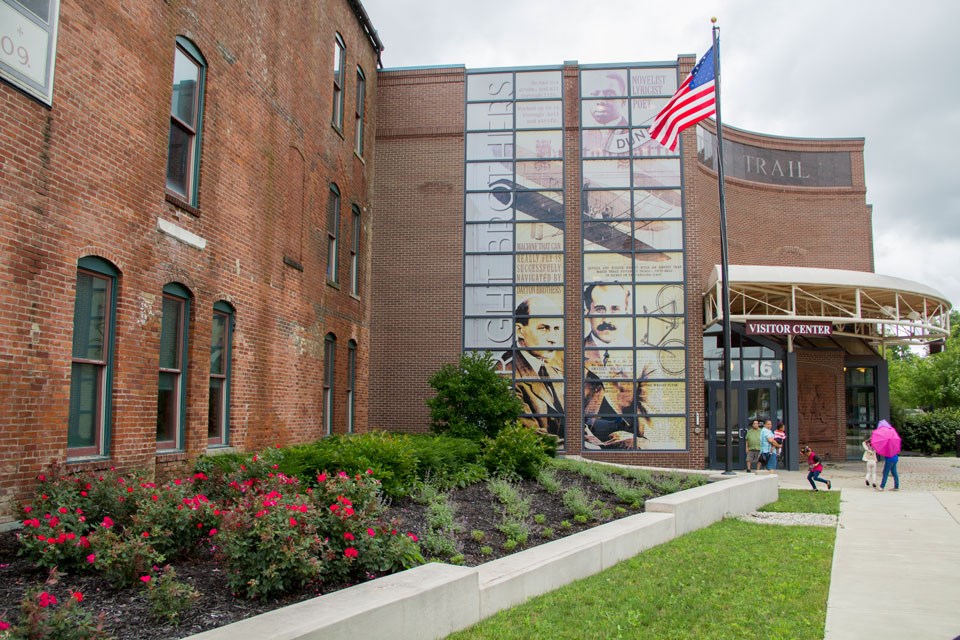
The Wright-Dunbar Interpretive Center is one of two visitor centers operated by the park in Dayton, Ohio. It’s located just west of downtown Dayton. Visitors can go there and learn the amazing story of Orville and Wilbur Wright.
The Center also celebrates the achievements of Paul Laurence Dunbar. Dunbar was an American poet, novelist, and short story writer. He was born in Dayton, Ohio, on June 27, 1872, to parents who had been enslaved in Kentucky before the American Civil War.
Dunbar went on to become one of the first influential African-American poets in American literature.
You can purchase this gifted writer’s complete works. The Life And Works Of Paul Laurence Dunbar: Containing His Complete Poetical Works, His Best Short Stories, Numerous Anecdotes And A Complete Biography Of The Famous Poet is a great way to learn more about this amazing man while experiencing his incredibly body of work.
Visit The Site Where Aviation History Began
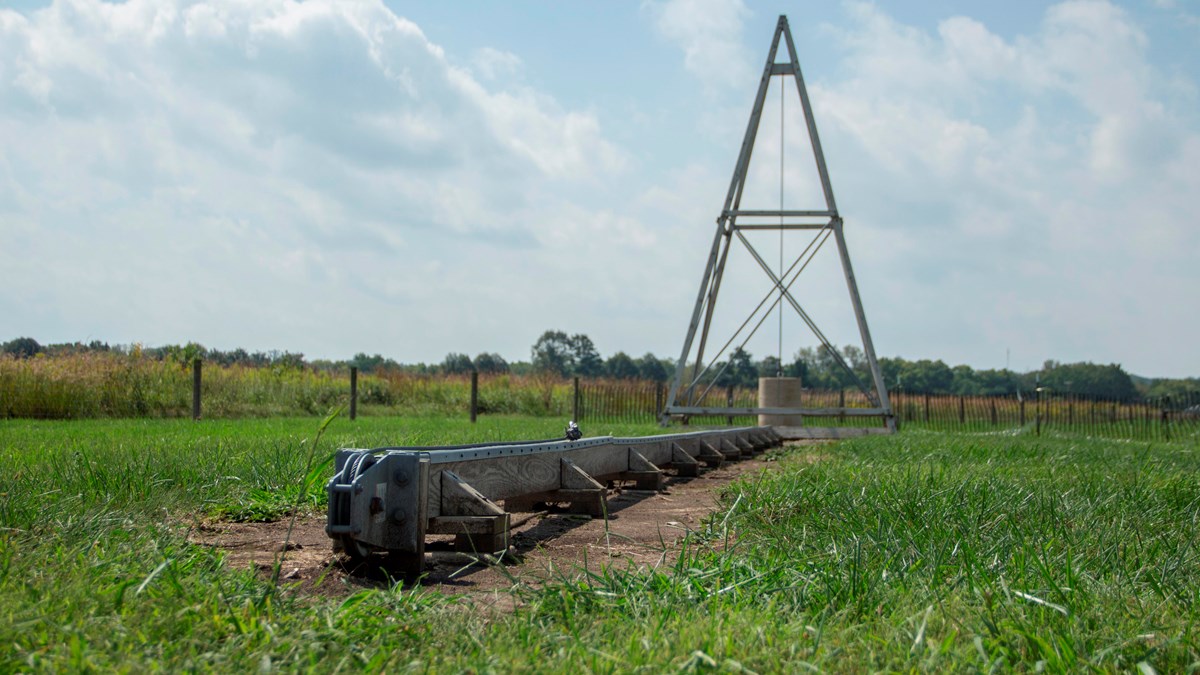
There is a second interpretative center. It’s the Huffman Prairie Interpretive Center. It’s located northeast of downtown Dayton, next to the Wright Patterson Air Force Base and the National Museum of the Air Force.
While you’re there you’ll have the opportunity to visit the site where aviation history began.
At Huffman Prairie Flying Field you can explore the area and view a replica hangar that is very similar to the one which the Wrights used to house their airplanes.
You can also tour a replica of the bike shop that the Wright Brothers operated. It’s part of Dayton Aviation Heritage National Historical Park.
Visitors can step back in time and tour the bike shop where the Wrights fixed bicycles and refined their mechanical ingenuity to develop the world’s first practical airplane.
And there’s Carillon Historical Park. It’s a 65-acre open-air history museum you can learn about the history of Dayton, Ohio. There you can view the world’s first practical airplane, the 1905 Wright Flyer III.
List Of Historic Sites In Ohio
- Dayton Aviation Heritage National Historical Park
- Rock & Roll Hall Of Fame
- Cuyahoga Valley National Park
- William Howard Taft National Historic Site
- First Ladies National Historic Site
- Charles Young Buffalo Soldiers National Monument
- Perry’s Victory & International Peace Memorial
- Pro Football Hall Of Fame
- James A. Garfield National Historic Site
- Hopewell Culture National Historic Park
- Lewis & Clark National Historic Trail
- National Museum Of The United States Air Force
- Thomas Edison Birthplace Museum
- Armstrong Air & Space Museum
- The Ohio Statehouse
Why Trust Us About Historic Sites In Ohio?
We’re Jim Pattiz and Will Pattiz, collectively known as the Pattiz Brothers and we absolutely LOVE the national parks.
You should probably know that we don’t just make this stuff up out of thin air. We’ve spent our entire adult lives exploring and filming America’s national parks and public lands.
We’ve worked with the National Park Service, the Department of Interior, USDA, U.S. Forest Service, and more for years creating films on important places and issues. Our work has been featured in leading publications all over the world and even some people outside of our immediate family call us experts on the national parks.
And, in 2018, our father – having spent a lifetime teaching history – joined us so that he could help us to tell the stories behind these amazing places.
Meet The Parks Brothers
We Hope You’ll Follow Our Journey

Our goal here at More Than Just Parks is to share the beauty of America’s national parks and public lands through stunning short films in an effort to get Americans and the world to see the true value in land conservation.
We hope you’ll follow our journey through the parks and help us to keep them the incredible places that they are. If you’re interested in joining the adventure then sign up below!
Related Links
To learn more about the difference between the various National Park Service designations check out our article that explains everything!
Ohio National Parks: 10 EPIC Ohio National Parks Worth Visiting
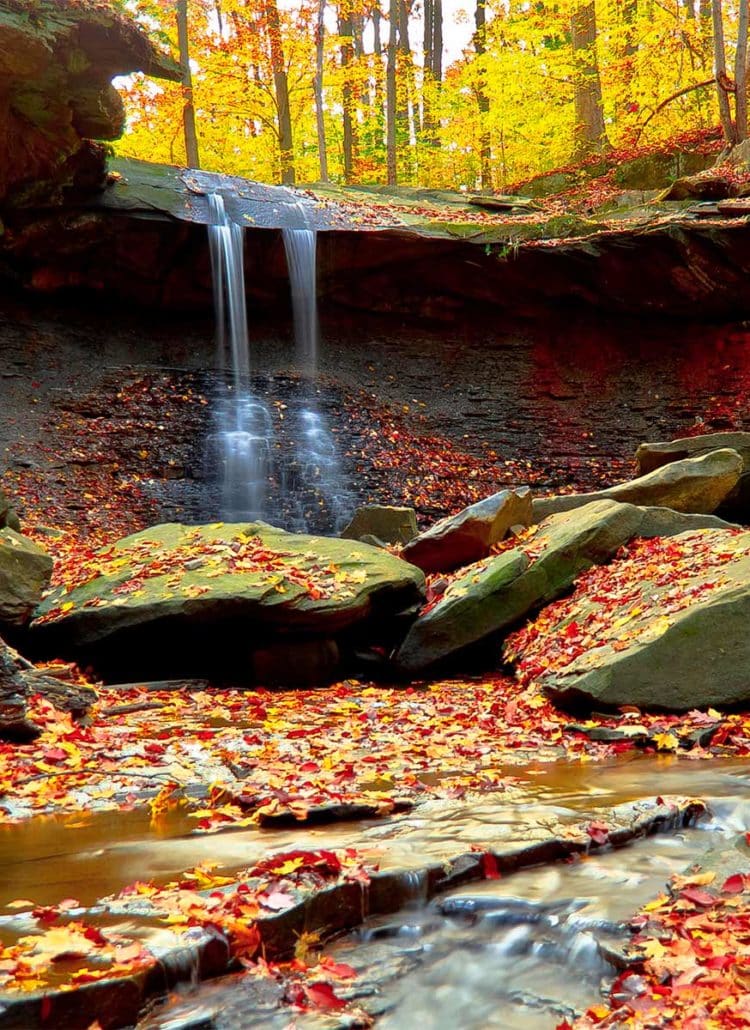



Leave a Reply